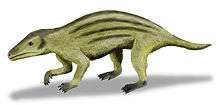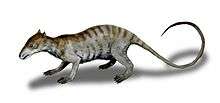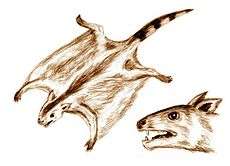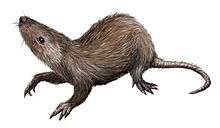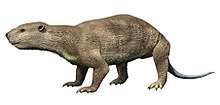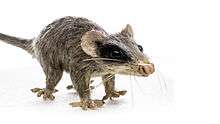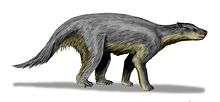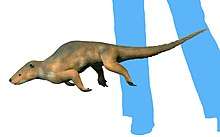Borealestes
Borealestes was a genus of docodont from the Middle Jurassic of Britain, first discovered on the Isle of Skye near the village of Elgol. It was the earliest mammal from the Mesozoic found and named in Scotland[1] and was later found in other Middle Jurassic sites in England, where a second species was also named.
| Borealestes | |
|---|---|
| Scientific classification | |
| Kingdom: | Animalia |
| Phylum: | Chordata |
| Clade: | Therapsida |
| Clade: | Cynodontia |
| Clade: | †Docodonta |
| Genus: | †Borealestes Waldman and Savage, 1972 |
| Type species | |
| †Borealestes serendipitus Waldman and Savage, 1972 | |
| Other species | |
| |
Discovery
The first fossil of Borealestes serendipitus was discovered by Dr Michael Waldman during a school field trip he was leading on the Isle of Skye. The holotype is a fragment of jaw containing five molars and three premolars (BRSUG 20572)[1][2] and there are several other jaw fragments known, all of them from the Kilmaluag Formation. Michael Waldman and Robert J. G. Savage then carried out multiple trips to the island in search of mammals and other fossils. They named Borealestes at the same time as a new species of tritylodontid, Stereognathus 'hebridicus' (now synonymised with S. ooliticus[3]). The specific name derives from the Greek Boreas and Latin Boreal, meaning northern, the Greek listís meaning brigand or rogue, and the noun serendipity, relating to making a happy and unexpected discovery by accident.[1]
After its discovery and naming, Borealestes was also found at Kirtlington Cement Quarry in England, and at Watton Cliff, both Middle Jurassic fossil sites.[4] Both of these localities belong to the Forest Marble Formation.
In 2003, Borealestes mussettae (originally 'B. mussetti') was named from isolated molars found in the Bathonian aged Kirtlington Mammal bed of Oxfordshire, England.[4] It differs from B. serendipitus in the details of cusps and ridges on the molar teeth. The species name mussetti was in honour of Dr Frances Mussett, in recognition of her major participation in fossil excavation at Kirtlington Cement Quarry. However, mussetti is the masculine form, and so this has been amended to mussettae by subsequent authors.[5][2]
Appearance
Borealestes is currently only known from fragments of lower jaw[2], multiple isolated teeth, and ear bones ( petrosals[6]). Docodonts are small (shrew to rat sized) mammals. Borealestes is believed to be a basal member of Docodonta.[7]
References
- Waldman, M.; Savage, R. J. G. (1972). "The first Jurassic mammal from Scotland". Journal of the Geological Society. 128 (2): 119–125. doi:10.1144/gsjgs.128.2.0119.
- Panciroli, E., Benson, R.B. and Luo, Z.X., 2019. The mandible and dentition of Borealestes serendipitus (Docodonta) from the Middle Jurassic of Skye, Scotland. Journal of Vertebrate Paleontology, 39(3), p.e1621884
- Panciroli, E., Walsh, S., Fraser, N.C., Brusatte, S.L., Corfe, I. 2017. A reassessment of the postcanine dentition and systematics of the tritylodontid Stereognathus (Cynodontia, Tritylodontidae, Mammaliamorpha), from the Middle Jurassic of the United Kingdom. Journal of Vertebrate Paleontology. 37 (5): e1351448
- Sigogneau-Russell D. 2003 Docodonts from the British Mesozoic. Acta Palaeontologica Polonica 48, 3, 357-374
- Averianov, A. O. 2004. Interpretation of the Early Cretaceous mammal Peraiocynodon (Docodonta) and taxonomy of some British Mesozoic docodonts. Russian Journal of Theriology 3:1–4.
- Panciroli, E., Schultz J.A., and Luo, Z-X. 2018. The morphology of the petrosal and stapes of Borealestes (Mammaliaformes, Docodonta) from the Middle Jurassic of Skye, Scotland. Papers in Palaeontology https://doi.org/10.1002/spp2.1233
- Luo Z-X, and Martin. 2007 Analysis of molar structure and phylogeny of docodont genera. Bulletin of the Carnegie Museum of Natural History 39: 27-47

